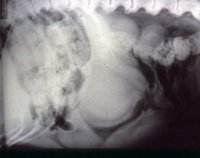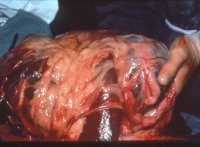
|
CANCER OF THE SPLEEN
Note for Pet Owners: This information is provided
by Provet for educational purposes only.
You should seek the advice
of your veterinarian if your pet is ill as only he or she can correctly
advise on the diagnosis and recommend the treatment that is most
appropriate for your pet. Topics on this Page:
|
Description
Cancer of the spleen is frequently seen in large breed dogs and by far the most
common type of cancer is hemangiosarcoma, a malignant form of cancer that
frequently spreads to other organ systems.
Other, less common forms of cancer of the spleen include :
- Hemangiomas (benign)
- Leiomyosarcomas
- Fibrosarcomas
- Non-neoplastic hematomas also occur
Definitive diagnosis can only be made bby histopathological examination of a removed spleen, or biopsy of lesions. Survival times are much better for the non-hemangiosarcoma tumours.
Cause
Hemangiosarcoma is a cancer of the vascular endothelium.
Breed Occurrence
Cancer of the spleen can occur in any dog - but it is most frequently seen in
large breeds or cross-breeds. The German Shepherd Dog is at increased risk
to develop hemangiosarcoma of the spleen compared to other breeds, and it
occurs most frequently in dogs aged 8-13 years of age.
Signs
- Sudden onset weakness and collapse
- Shock
- Anemia
- Abdominal distension
Complications
If the spleen is not removed repeated hemorrhages are likely, and the risk of spread increases greatly.
Diagnosis
Splenic hemangiosarcomas can usually be easily felt on abdominal palpation,
They are also easily identified as medium to large mid-ventral abdominal masses
on radiography and ultrasound examinations.
Treatment
Removal of the spleen (splenectomy) is the treatment of choice. Severely anemic
patients require intravenous fluid support, and very large tumours can put
pressure on vital organs such as the major blood vessels so positioning during
surgery (lie the animal slightly tilted to one side so the mass does not
compress the caudal vena cava) is important to minimise complications due to
pressure
Prognosis Long term problems
According to published papers the mean survival time in dogs with hemangiosarcom is only about 3-4 months, however there are cases that have
survived 1 year or more following surgery. This is most likely if the diagnosis
is made at the time of the first hemorrhage.
Updated October 2013
d>